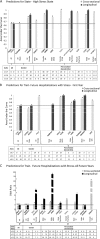Towards precision medicine for stress disorders: diagnostic biomarkers and targeted drugs
- PMID: 30862937
- PMCID: PMC7192849
- DOI: 10.1038/s41380-019-0370-z
Towards precision medicine for stress disorders: diagnostic biomarkers and targeted drugs
Abstract
The biological fingerprint of environmental adversity may be key to understanding health and disease, as it encompasses the damage induced as well as the compensatory reactions of the organism. Metabolic and hormonal changes may be an informative but incomplete window into the underlying biology. We endeavored to identify objective blood gene expression biomarkers for psychological stress, a subjective sensation with biological roots. To quantify the stress perception at a particular moment in time, we used a simple visual analog scale for life stress in psychiatric patients, a high-risk group. Then, using a stepwise discovery, prioritization, validation, and testing in independent cohort design, we were successful in identifying gene expression biomarkers that were predictive of high-stress states and of future psychiatric hospitalizations related to stress, more so when personalized by gender and diagnosis. One of the top biomarkers that survived discovery, prioritization, validation, and testing was FKBP5, a well-known gene involved in stress response, which serves as a de facto reassuring positive control. We also compared our biomarker findings with telomere length (TL), another well-established biological marker of psychological stress and show that newly identified predictive biomarkers such as NUB1, APOL3, MAD1L1, or NKTR are comparable or better state or trait predictors of stress than TL or FKBP5. Over half of the top predictive biomarkers for stress also had prior evidence of involvement in suicide, and the majority of them had evidence in other psychiatric disorders, providing a molecular underpinning for the effects of stress in those disorders. Some of the biomarkers are targets of existing drugs, of potential utility in patient stratification, and pharmacogenomics approaches. Based on our studies and analyses, the biomarkers with the best overall convergent functional evidence (CFE) for involvement in stress were FKBP5, DDX6, B2M, LAIR1, RTN4, and NUB1. Moreover, the biomarker gene expression signatures yielded leads for possible new drug candidates and natural compounds upon bioinformatics drug repurposing analyses, such as calcium folinate and betulin. Our work may lead to improved diagnosis and treatment for stress disorders such as PTSD, that result in decreased quality of life and adverse outcomes, including addictions, violence, and suicide.
Conflict of interest statement
ABN is listed as inventor on a patent application being filed by Indiana University and is a co-founder of MindX Sciences. The other authors declare that they have no conflict of interest.
Figures


Similar articles
-
Precision medicine for suicidality: from universality to subtypes and personalization.Mol Psychiatry. 2017 Sep;22(9):1250-1273. doi: 10.1038/mp.2017.128. Epub 2017 Aug 15. Mol Psychiatry. 2017. PMID: 28809398 Free PMC article.
-
Precision medicine for mood disorders: objective assessment, risk prediction, pharmacogenomics, and repurposed drugs.Mol Psychiatry. 2021 Jul;26(7):2776-2804. doi: 10.1038/s41380-021-01061-w. Epub 2021 Apr 8. Mol Psychiatry. 2021. PMID: 33828235 Free PMC article.
-
Understanding and predicting suicidality using a combined genomic and clinical risk assessment approach.Mol Psychiatry. 2015 Nov;20(11):1266-85. doi: 10.1038/mp.2015.112. Epub 2015 Aug 18. Mol Psychiatry. 2015. PMID: 26283638 Free PMC article.
-
Understanding the Molecular Mechanisms Underpinning Gene by Environment Interactions in Psychiatric Disorders: The FKBP5 Model.Biol Psychiatry. 2018 May 15;83(10):821-830. doi: 10.1016/j.biopsych.2018.01.021. Epub 2018 Mar 21. Biol Psychiatry. 2018. PMID: 29573791 Review.
-
[Posttraumatic stress disorder (PTSD) as a consequence of the interaction between an individual genetic susceptibility, a traumatogenic event and a social context].Encephale. 2012 Oct;38(5):373-80. doi: 10.1016/j.encep.2011.12.003. Epub 2012 Jan 24. Encephale. 2012. PMID: 23062450 Review. French.
Cited by 19 articles
-
The Molecular Basis of Resilience: A Narrative Review.Front Psychiatry. 2022 May 6;13:856998. doi: 10.3389/fpsyt.2022.856998. eCollection 2022. Front Psychiatry. 2022. PMID: 35599764 Free PMC article. Review.
-
How to Mitigate Risk of Premature Cardiovascular Disease Among Children and Adolescents with Mental Health Conditions.Curr Atheroscler Rep. 2022 Apr;24(4):253-264. doi: 10.1007/s11883-022-00998-9. Epub 2022 Mar 23. Curr Atheroscler Rep. 2022. PMID: 35320835 Free PMC article. Review.
-
Adaptation of Lipid Profiling in Depression Disease and Treatment: A Critical Review.Int J Mol Sci. 2022 Feb 12;23(4):2032. doi: 10.3390/ijms23042032. Int J Mol Sci. 2022. PMID: 35216147 Free PMC article. Review.
-
Altered gene expression and PTSD symptom dimensions in World Trade Center responders.Mol Psychiatry. 2022 Apr;27(4):2225-2246. doi: 10.1038/s41380-022-01457-2. Epub 2022 Feb 17. Mol Psychiatry. 2022. PMID: 35177824
-
Convergent Functional Genomics approach to prioritize molecular targets of risk in early life stress-related psychiatric disorders.Brain Behav Immun Health. 2020 Aug 2;8:100120. doi: 10.1016/j.bbih.2020.100120. eCollection 2020 Oct. Brain Behav Immun Health. 2020. PMID: 34589878 Free PMC article. Review.
References
Publication types
MeSH terms
Substances
Grant support
LinkOut - more resources
Full Text Sources
Medical
Research Materials
Miscellaneous

